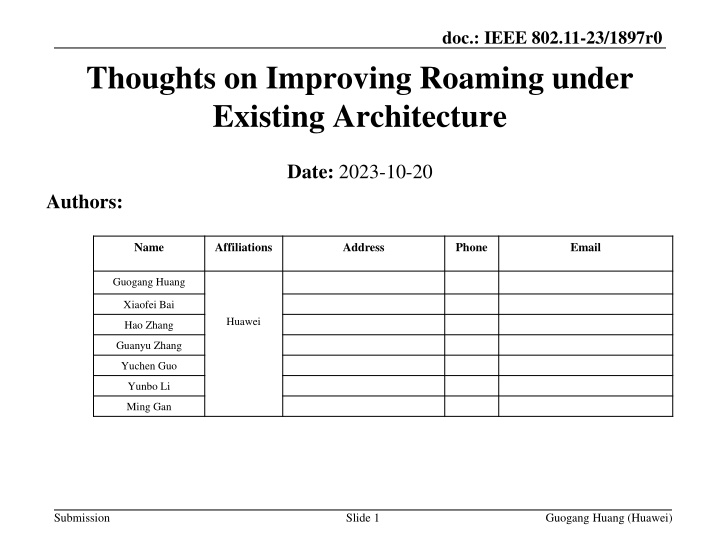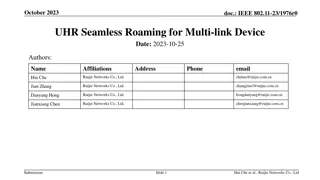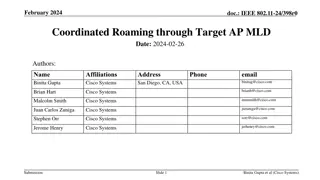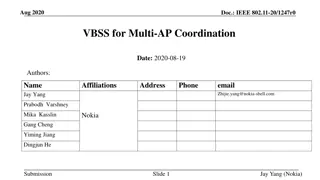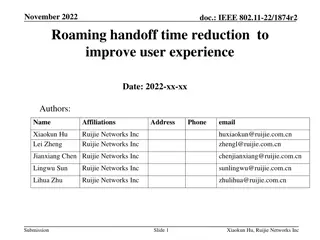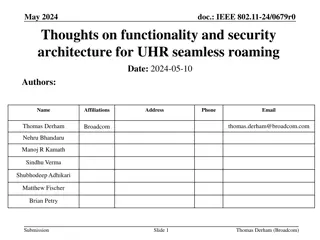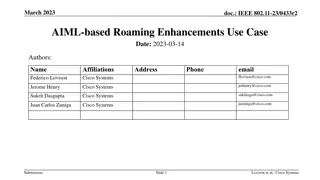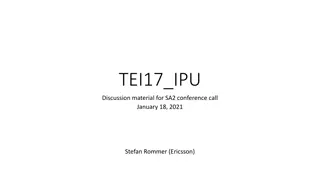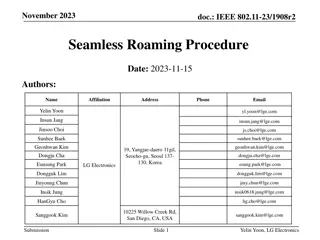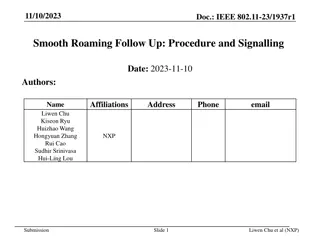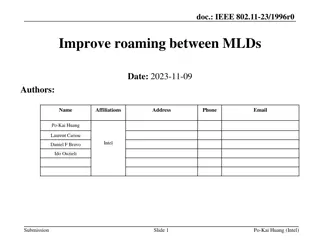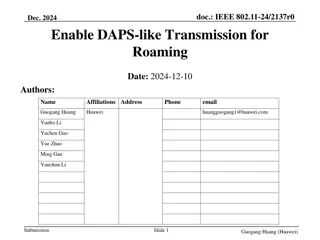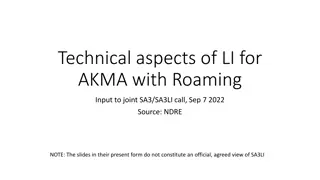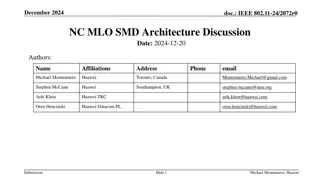Thoughts on Improving Roaming under Existing Architecture
This document discusses potential research directions to enhance roaming performance in IEEE 802.11 networks, focusing on hot-standby association and improving data continuity and beacon measurements. It introduces proposals for over-the-DS hot-standby association to address transmission rate drops and optimize roaming performance.
Uploaded on Feb 27, 2025 | 2 Views
Download Presentation

Please find below an Image/Link to download the presentation.
The content on the website is provided AS IS for your information and personal use only. It may not be sold, licensed, or shared on other websites without obtaining consent from the author.If you encounter any issues during the download, it is possible that the publisher has removed the file from their server.
You are allowed to download the files provided on this website for personal or commercial use, subject to the condition that they are used lawfully. All files are the property of their respective owners.
The content on the website is provided AS IS for your information and personal use only. It may not be sold, licensed, or shared on other websites without obtaining consent from the author.
E N D
Presentation Transcript
doc.: IEEE 802.11-23/1897r0 Thoughts on Improving Roaming under Existing Architecture Date: 2023-10-20 Authors: Name Affiliations Address Phone Email Guogang Huang Xiaofei Bai Huawei Hao Zhang Guanyu Zhang Yuchen Guo Yunbo Li Ming Gan Submission Slide 1 Guogang Huang (Huawei)
doc.: IEEE 802.11-23/1897r0 Abstract To improve the roaming performance between MLDs, there are three potential research directions so far. Hot-standby association[1-3] i.e. the non-AP MLD completes all the negotiations (e.g. security handshake, link setup and so on) with one or more neighboring AP MLDs in advance except switching the data path. The non-AP MLD is still associated with the current AP MLD. Improve data continuity by transferring Tx/Rx context [4] Improve Beacon Request/Report measurement [5] In this contribution, we discuss some other candidate directions, e.g. Enable over-the-DS hot-standby association Improve Beacon Request/Report measurement Optimize IP address request procedure Submission Slide 2 Guogang Huang (Huawei)
doc.: IEEE 802.11-23/1897r0 Enable over-the-DS hot-standby association For the roaming based on the hot-standby association, we have the following observations, The transmission rate drops seriously during the roaming due to the poor link quality. Since at least one affiliated STA needs to switch to the corresponding channel and do the hot-standby association with one or more neighboring AP MLDs, this also will affect the data transmission and accordingly cause the drop of the overall transmission rate. This phenomenon is more serious for the eMLSR non-AP MLD, as it only has one regular radio for the data transmission. 11bn should provide an method to improve the roaming performance for all types of non-AP MLDs. Submission Slide 3 Guogang Huang (Huawei)
doc.: IEEE 802.11-23/1897r0 Proposal 1 We propose to design an over-the-DS hot-standby association (which is similar to the existing over-the-DS FT protocol). Specifically, The non-AP MLD exchanges FT Probe Request/Response frames with the current AP MLD to get info on neighboring AP MLDs The non-AP MLD exchanges FT Reassociation Request/Response frames with the current AP MLD to do hot-standby associations with neighboring AP MLDs Thus the non-AP MLD doesn t need to switch the channel unless it is measuring RSSIs of neighboring AP MLDs. Fig. 2 Procedure of proposed improved roaming with hot- standby association Fig. 1 Existing architecture Submission Slide 4 Guogang Huang (Huawei)
doc.: IEEE 802.11-23/1897r0 Proposal 1 (Cont.) By defining the over-the-DS hot-standby association, we can provide a competitive performance compared with the roaming performance under the non-colocated AP MLD architecture. Because in the non-colocated AP MLD, the non-AP MLD shall exchange Link Reconfiguration Request/Response frames with the current colocated AP MLD to add links with neighboring colocated AP MLDs. It s reasonable to allow that the non-AP MLD can exchange Probe Request/Response frames with the current colocated AP MLD to get the info on neighboring colocated AP MLDs. Non-colocated AP MLD Non-colocated AP MLD common MAC MLD common MAC MLD common MAC AP 2 AP 1 AP 1 AP 2 (Colocated) AP MLD Neighboring (colocated) AP MLD Fig. 2 Procedure of roaming under non- colocated AP MLD architecture STA 2 STA 1 MLD common MAC Non-AP MLD Fig. 3 Non-colocated AP MLD architecture Submission Slide 5 Guogang Huang (Huawei)
doc.: IEEE 802.11-23/1897r0 Improve Beacon Request/Report measurement Considering the following reasons, a more efficient measurement is required Regardless of measurement mode (active/passive), it typically takes more than 100- 200ms to complete the measurement process.[5] For passive measurement, Beacon interval is usually set to 100-200ms. In cases where a STA fails to receive a Beacon from an OBSS AP for some reason, the measurement process will take even longer. For active measurement, STA allocates approximately 100-200ms to collect probe responses from all APs. Different vendors have different implementations of the Beacon Request/Report measurement protocol, e.g. The AP requests a STA to do the Beacon Request measurement, but the STA cannot feed back the Beacon Report in time or it ignores the measurement request due to some reason. Since different vendors have different calculation methods, the RCPI and RSNI values reported by different vendors vary widely. Seamless roaming needs a more efficient measurement Submission Slide 6 Guogang Huang (Huawei)
doc.: IEEE 802.11-23/1897r0 Proposal 2 We propose to define a new measurement mode for the Beacon Request measurement to allow the STA to use the NDPR+NDPA+NDP procedure to speed up the measurement. Detail Procedure AP1 requests STA1 to do a Beacon Request measurement with the new measurement mode. STA1 switches to CH2 and sends a NDPR to request AP2 to send a test signal (e.g. NDPA + NDP) AP2 sends a test signal STA1 switches to CH3 and sends a NDPR to request AP3 to send a test signal AP3 sends a test signal STA1 feeds back the Beacon Reports to AP1. STA1 AP2 (CH2) AP1 (CH1) AP3 (CH3) Submission Slide 7 Guogang Huang (Huawei)
doc.: IEEE 802.11-23/1897r0 Optimize IP address request procedure Target AP STA Current AP When a STA is roaming from the current AP to a target AP, it will initiate an IP address request to update its IP address. If the STA supports the FILS (fast initial link setup) protocol, it can directly include a FILS IP Address Assignment element within (Re)association Response frames to speed the roaming procedure. But the FILS protocol hasn t been widely used in products. Actually, at some cases, the IP address assignment update is not needed if the following condition is true The current AP and the target AP are within the same layer-2 network and are served by the same DHCP server. Beacon Request Probe Request Probe Response Beacon report BTM Request BTM Response Request and FT Request FT Response Reassociation Request Reassociation Response Encrypted Data [DHCP Discover] Encrypted Data [DHCP Offer] Encrypted Data [DHCP Request] Encrypted Data [DHCP ACK] Submission Slide 8 Guogang Huang (Huawei)
doc.: IEEE 802.11-23/1897r0 Proposal 3 Hence, we propose to add a bit (e.g. IP Address Update Required) in the Neighbor Report element to indicate whether the STA needs to request the IP address update when it roams to this reported AP. If the IP Address Update Required bit is equal to 1, the STA shall request a new IP address by including a FILS IP Address Assignment element within (Re)association Request and Response frames or initiating a separate IP address request procedure. Otherwise, the STA shall not request a new IP address. Submission Slide 9 Guogang Huang (Huawei)
doc.: IEEE 802.11-23/1897r0 References [1] 11-20-0834-09-00be-tentative-re-association-for-non-ap-mld [2] 11-22-1580-01-0uhr-aperspectiveonproposeduhrfeaturesforenterpriseusecases [3] 11-23-0324-01-0uhr-roaming-requirements [4] 11-23-0322-00-0uhr-improve-roaming-between-mlds [5] 11-23-0668-02-0uhr-coordinated-measurement Submission Slide 10 Guogang Huang (Huawei)
doc.: IEEE 802.11-23/1897r0 Annex When a STA successfully associates with an AP, it will initiate an IP address request. Specifically, STA sends a DHCP Discover message in a broadcast manner. DHCP server replies a DHCP Offer message with an allocated IP address in a broadcast manner. STA takes out the allocated IP address and sends a DHCP Request Message to DHCP server. DHCP server replies a DHCP ACK Message. Submission Slide 11 Guogang Huang (Huawei)
